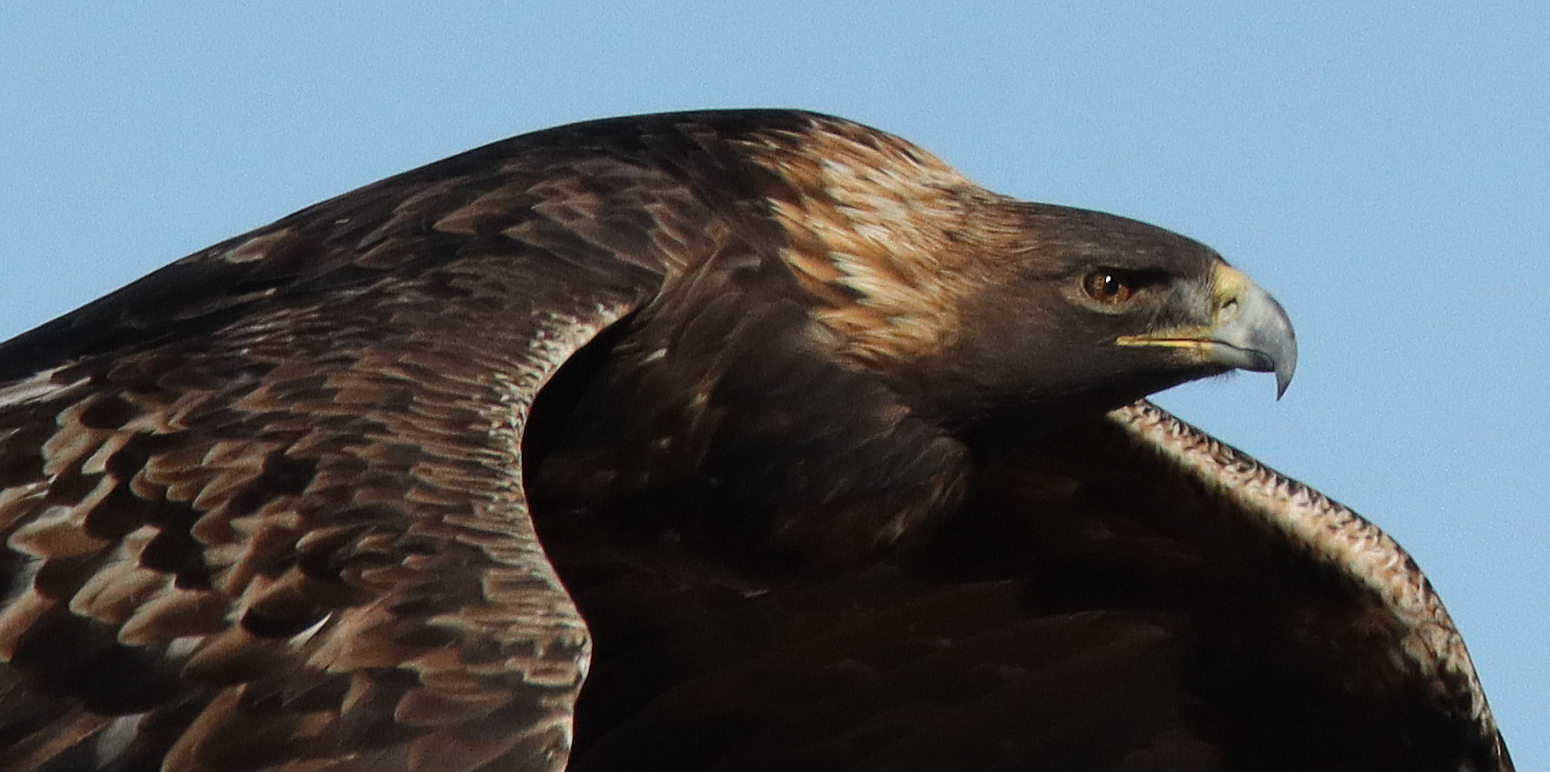
An impressive adult Golden Eagle provided a memorable and exciting photo session as it flew toward and past Paul with the sun at his back and the camera’s lens focused on its eye. See more photos of this eagle in flight in the Bird Photography article in this issue.
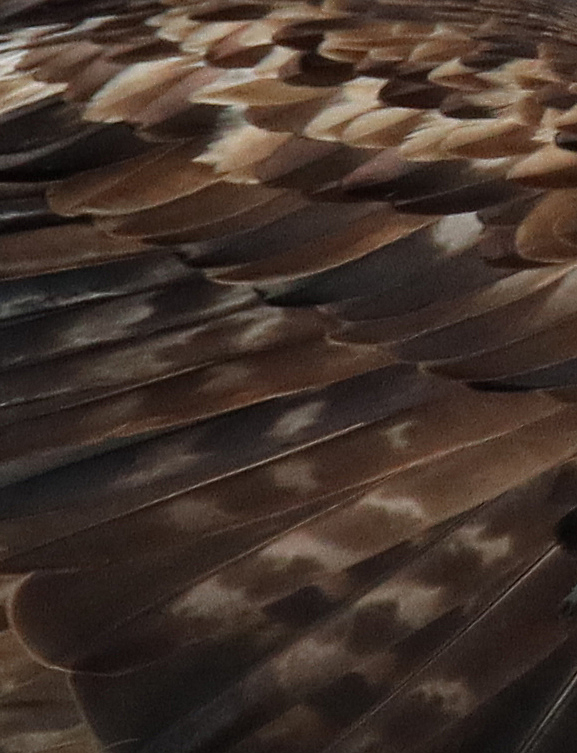
A super-close look at feathers on the wing of the Golden Eagle, a product of extreme cropping of a photo of the eagle. At the top of the image you can see many covert feathers, with secondary wing feathers below.
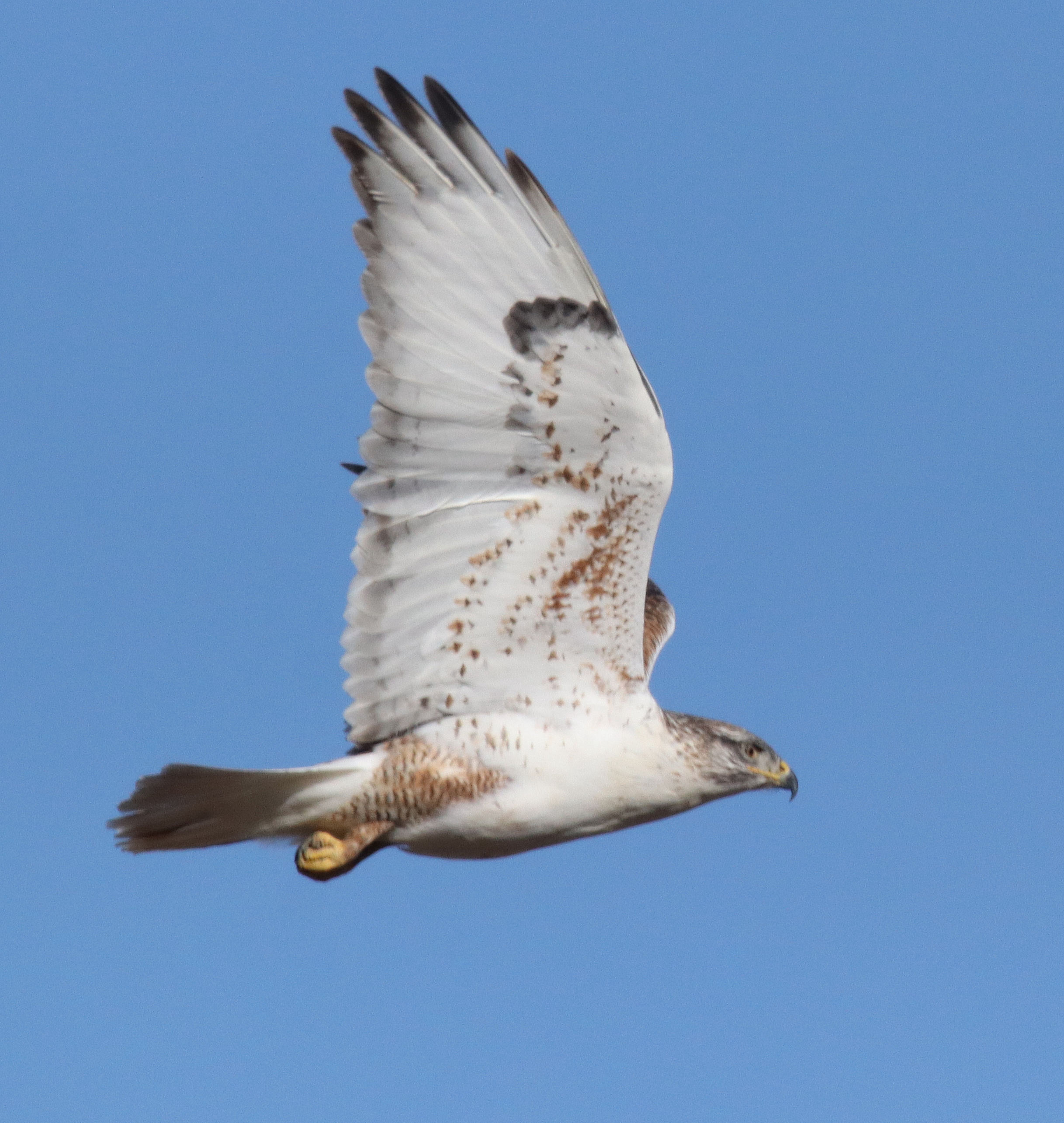
While trying to photograph a Bald Eagle on the hunt along a range of hills, a Ferruginous Hawk began soaring in the same area after it appeared on the top of a classic windmill.
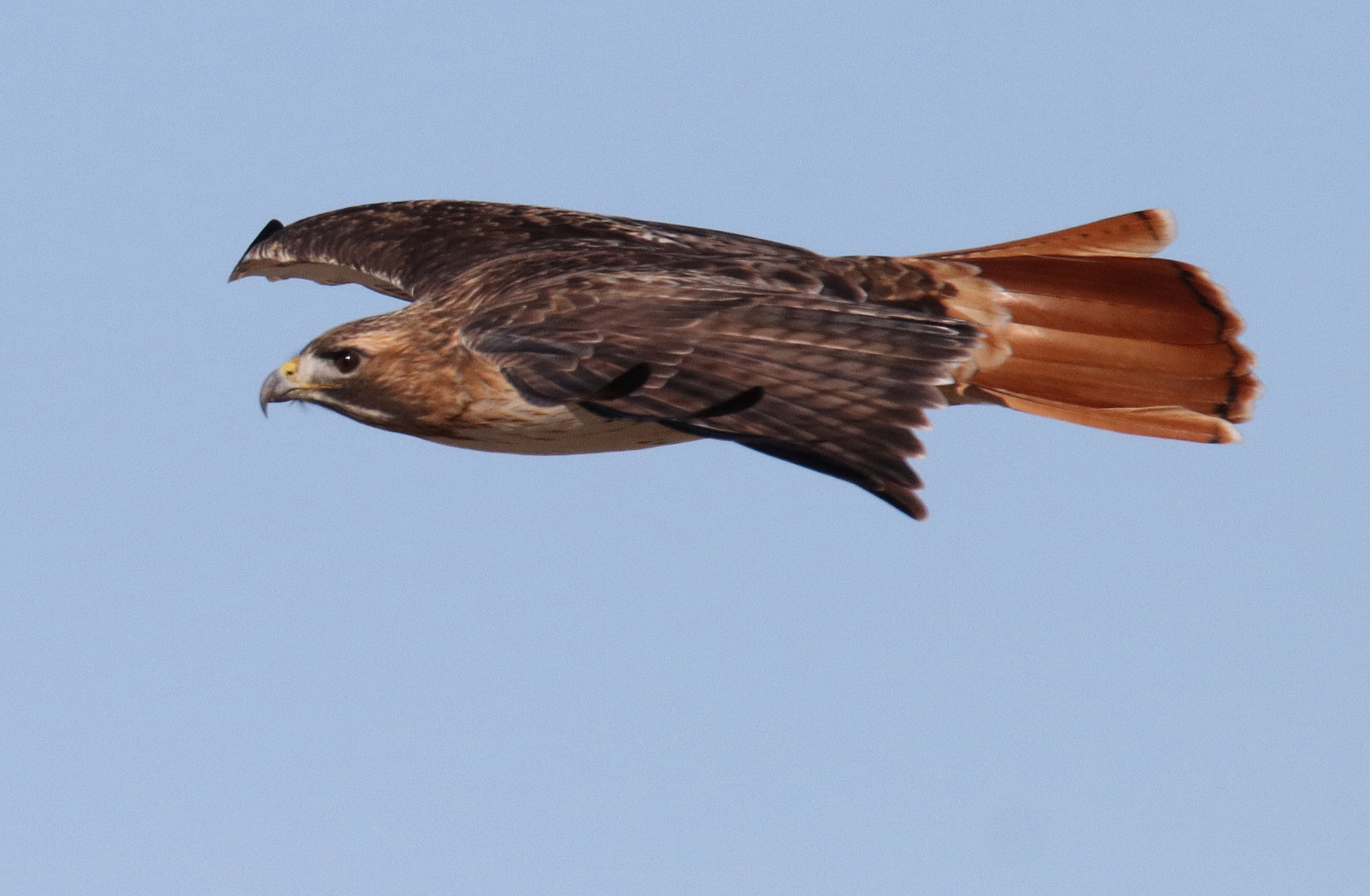
An adult Red-tailed Hawk was photographed as it was gliding at eye level. Compare this “normal” Red-tail with the light morph Harlan’s Red-tail illustrated below.
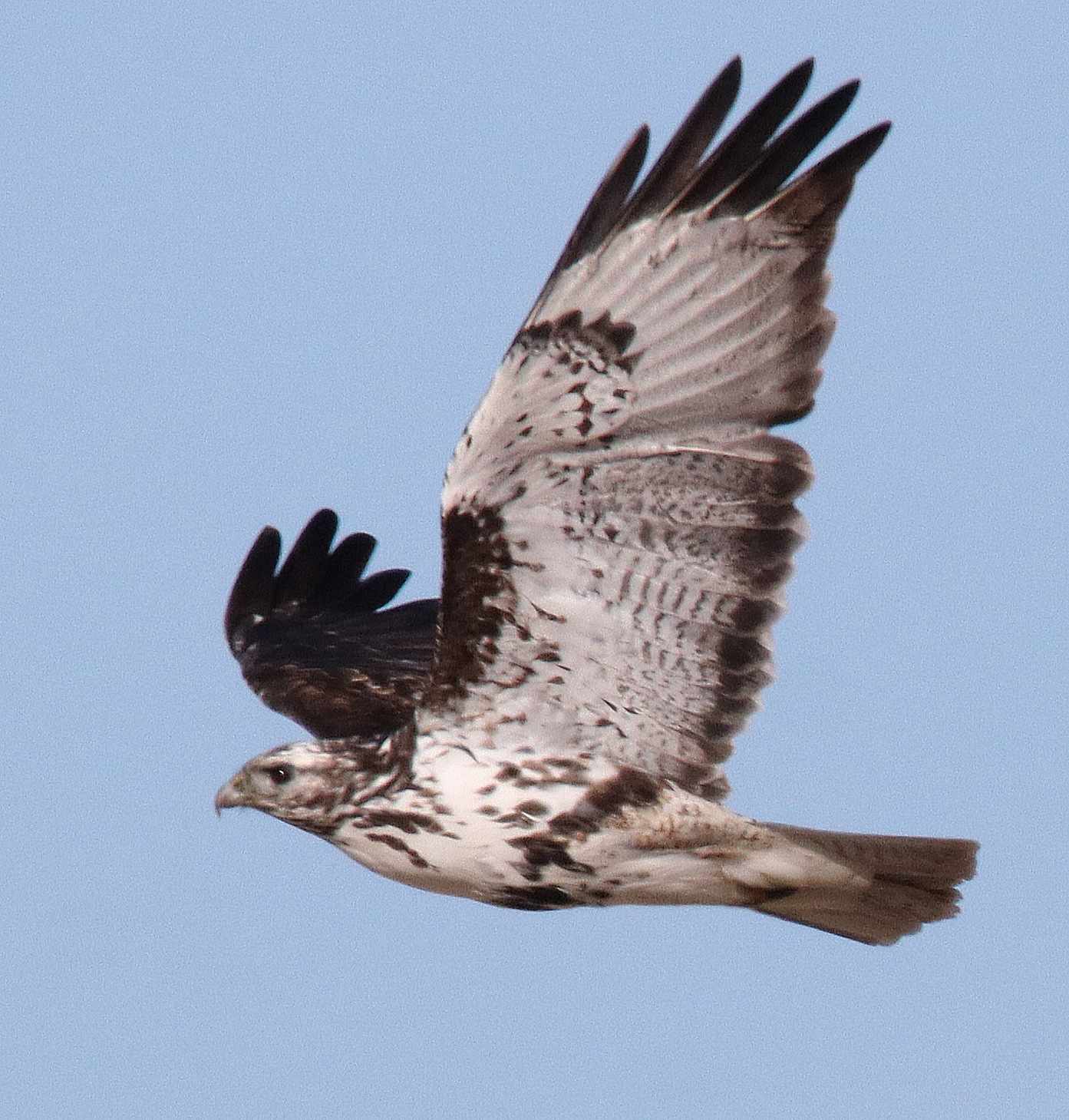
This image of the light morph Harlan’s Red-tailed Hawk shows how uniquely colored it is compared to any other hawk Paul has ever seen. But the most interesting thing about this raptor is that it has returned to the same winter territory for several years in a row, often seen using the same perches year after year.
|
A break in the weather offered low wind on an extra-sunny non-work day gave me the chance to return to my SoDak winter raptor survey route, centered at the capitol in Pierre! Overall, it was an exciting day with a minimum of raptors on hand, but with such impressive birds as Golden Eagles, Bald Eagles, Rough-legged Hawks, Red-tailed Hawks including 1 Harlan’s, and a single Ferruginous Hawk – 5 species and 24 birds of prey total. Like the month before, fewer numbers of raptors actually translated into more photo opportunities, including all 5 species last Wednesday.
Conducted a month after my last survey, it was an excellent break from the norm, and a long day with hours of darkness behind the wheel of my car, coming and going; but the chance to census and photograph eagles, hawks, falcons, and other birds during daylight hours made it so much fun I didn’t get tired at all. In the end, no falcons were on hand even though Prairie Falcons, Merlins, and even Gyrfalcons are possibilities as January melts into Ground Hog’s Day. There weren’t many other species of birds in the survey area beyond Ring-necked Pheasants and a couple large flocks of Horned Larks – oh, and scattered groups of Western Meadowlarks in the southern-most area – south of the little town of Presho.
Back to raptors, the totals for the day were 4 Golden Eagles, 5 Bald Eagles, 1 Ferruginous Hawk, 6 Rough-legged Hawks, 8 Red-tailed Hawks including 1 light morph Harlan’s Red-tail, the returning hawk that has occupied the same winter territory for most of the years I’ve been doing this raptor survey – pretty amazing to me. There are also a couple returning dark morph Harlan’s just north of Pierre, but during this trip I didn’t see any dark morph raptors during my quick drive-by through the area (as usual) and the dark morph Harlan’s I observed during the 2 previous surveys may simply have been out of sight for some moments or hours. The dark morph and light morph Harlan’s are essentially “marked” birds due to their rarity, so it’s always fun to keep track of them.
Comparing the January 29th survey totals of 5 species and 24 raptors total, a month earlier my December 26th SoDak winter raptor survey totaled 6 species and 29 total raptors (6 Golden Eagles, 4 Bald Eagles, 1 Merlin, 3 Northern Harriers, 5 Rough-legged Hawks, and 10 Red-tailed Hawks of which there was 1 light morph and 4 dark morph Harlan’s Red-tails). Three weeks earlier, during my first SoDak survey of the winter on December 6th, there were 10 species and 42 raptors (1 Golden Eagle, 4 Bald Eagles, 1 Prairie Falcon, 1 Merlin, 3 American Kestrels, 6 Northern Harriers, 1 Cooper’s Hawk, 3 Ferruginous Hawks, 7 Rough-legged Hawks, and 15 Red-tailed Hawks including 4 dark morph Harlan’s Red-tails). Overall, the first survey was fairly normal with bolstered numbers likely owing to mild late fall weather and the presence of some migrating kestrels, harriers, and Red-tails.
It's also interesting to compare late January SoDak surveys from previous years, which include the January 27, 2024 count of 6 species and 47 raptors (5 Golden Eagles, 6 Bald Eagles, 1 American Kestrel, 6 Northern Harriers, 1 Cooper’s Hawk, 6 Ferruginous Hawks, 12 Rough-legged Hawks, and 13 Red-tailed Hawks, including 1 light morph and 3 dark morph Harlan’s Red-tails). On January 21, 2023 there was a count of 7 species and 48 raptors (13 Golden Eagles, 8 Bald Eagles, 1 Prairie Falcon, 1 Merlin, 9 Ferruginous Hawks, 8 Rough-legged Hawks, and 8 Red-tailed Hawks, including 1 light morph and 2 dark morph Harlan’s Red-tails).
Obviously the late January 2025 numbers totaled half as many birds of prey as during the previous years of 2024 and 2023, but species diversity stayed about the same. Each survey is a special event for me, and in addition to identifying and counting the birds, I have a chance to observe and photograph some of them during each winter trip to SoDak. The best images I took last week are featured in this article, and the best Golden Eagle images illustrate the Bird Photography article at the end of this issue.
Feeding Station Questions
After a couple weeks without a woodpecker sighting, a male Hairy Woodpecker arrived at my platform feeder Saturday afternoon, potentially the same bird that has been on hand a few months – but where has it been? Or is it a different bird? (Its behavior suggested it was the same bird.) The return of a male Hairy Woodpecker reminded me that there is the potential for yet another Sunday return of a Blue Jay, which has happened exclusively the past 3 Sundays, with no jays heard or seen any other days during those weeks – crazy huh?
Sunday, I was aware and somewhat alert for the possibility of a Blue Jay visit, even though visits exclusively on the 3 previous Sundays was outlandish, and the chance of a 4th repeat even more beyond belief. But there I was, working with the television on in the background, when I heard the faint call of a Blue Jay, repeated 2 more times. Would the jay show itself in my yard or at my feeders? That’s when I put 2 and 2 together and realized the Blue Jay calls had materialized from the television program I was monitoring as I worked – ha-ha! I still didn’t give up on the scant potential for a jay visit, but as darkness cloaked my feeding station, it clearly was not to be this Sunday.
Nonetheless, the Harris’s Sparrow persists, along with White-breasted Nuthatches and House Finches, but yard birds have been extremely low on the variety scale. But wait, Tuesday morning 2 new birds were foraging on the ground around my feeding station – 2 Oregon race Dark-eyed Juncos. Owing to the fact that I had 2 Oregons visiting my yard for an extended period until early January, I immediately wondered if they were the same birds. But one of the previous Oregon juncos was quite petite in size with richer colored plumage, and these 2 were normally sized and colored Oregons, so at least one and probably both are New birds! That afternoon I watched 2 “normal” Dark-eyed Juncos foraging beneath my feeders, and there was an Oregon junco in my front yard too. It was nice to see a little change, and perhaps more new or returning birds will follow.
NoDak – Birds or No Birds?
As an avid birder, it’s been a bit bleak across North Dakota lately, with no birds observed during a recent trip to Bismarck, paired with another bird-less drive to Fargo on Friday. In fact, I couldn’t even locate a Gray Partridge in my study area on the southwest edge of Fargo. But after a bird-less drive southeast of my office last Thursday morning to double-check to see if the Bald Eagle from the previous Monday and Thursday might be around, I decided to take advantage of the sunny afternoon and head northwest.
Again, no birds, until halfway through my second birding drive of the day. I actually drove a very remote one-lane road I’d never followed before through some interesting prairie hills and eventually some cropland. In the prairie area a flock of 12 Sharp-tailed Grouse flushed as I topped a tall hill, and after that a series of 3 lone male Ring-necked Pheasants showed, all standing tall in the late afternoon sunlight, beaming bright red from their colorful breast feathers.
Thereafter, the weather wasn’t conducive for birding, and with bird sightings at a minimum I didn’t devote more time to birding. Looking at the weather forecast for the week ahead, it would be a good time to be in California, Florida, Texas, Arizona, or Mexico but that’s probably not in the cards for now, so maybe I’ll just review some photos from past winter trips to those locations and do a few home improvement projects until birds lure me back into the field. (Realistically though, I’ll be doing periodic checks for birds to keep abreast of any breakthroughs in bird numbers locally.) In the meantime, “Best Wishes” for better birding to you, and keep in mind that the next big birding event is coming up February 14 to 17 – the Great Backyard Bird Count.
Article and Photos by Paul Konrad
Share your bird sightings and photographs at editorstbw2@gmail.com